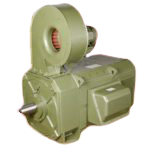
The DC motor is an electro-mechanical device. The fundamental operation of a DC motor relies on the principles of magnetism. It is made up of two major components: the stationary stator (magnets and steel housing) that
is on the outside and the armature inside which is comprised of laminations, copper wire and a commutator connected to the output shaft.
Typically, DC voltage flows through the brushes into the commutator. This creates a magnet field which is in opposite polarity to the permanent magnets on the housing. This pushes the coils away from the magnets they are facing,
and causes the rotor to turn. Because the commutator has multiple segments the armature motion indexes the rotor to the next set of coils on the armature, replicating the same motion yet again. Essentially, the brushes that are
located within the brush DC Motor turn it off and on when instructed by transferring the electricity from the rotor.
The major advantage of the brushed DC motor is its high linear torque, linear speed to voltage and, of course, low cost. Since a brushed DC motor can be operated directly from a battery (DC) or a simple SCR rectifier and can be manufactured with a large speed range they are still used extensively in many applications. These motors have had resurgence in their use and popularity with the use of low cost Tri-Ac, SCR and PWM controls.
The Brush DC Motor is commonly found in household applications. It can also be found in the industrial world because of its versatility in altering its torque-to-speed ratio.
If you would like us to prepare a competitive quote on DC motors, please contact our sales team.